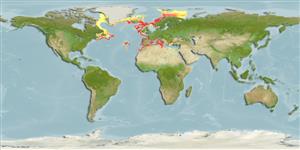Classification / Names
Common names from other countries
Main reference
Size / Weight / Age
Max length : 155 cm TL male/unsexed; (Ref. 1371); max. published weight: 30.0 kg (Ref. 35388); max. reported age: 20 years (Ref. 1371)
Length at first maturity
Lm 86.5 range ? - 88 cm
Environment
Marine; demersal; non-migratory; depth range 150 - 1000 m (Ref. 54594), usually 350 - 500 m (Ref. 54594)
Climate / Range
Temperate, preferred 5°C (Ref. 107945); 79°N - 29°N, 65°W - 44°E (Ref. 54594)
Distribution
Northeast Atlantic: Southwestern Barents Sea, sometimes north to Spitsbergen, southeastern Greenland, southern coast of Iceland, around the British Isles and south to Morocco and into the western Mediterranean. Northwest Atlantic: Newfoundland.
Countries | FAO areas | Ecosystems | Occurrences | Introductions
Short description
Dorsal
spines
(total): 0;
Anal
spines: 0;
Anal
soft rays: 70 - 81. Lower jaw longer than upper jaw; barbel shorter than eye diameter. Back gray-brown, grading to white ventrally. Posterior portions of vertical fins dark with pale margins.
IUCN Red List Status (Ref. 115185)
Threat to humans
Harmless
Human uses
Fisheries: commercial
More information
ReferencesAquacultureAquaculture profileStrainsGeneticsAllele frequenciesHeritabilityDiseasesProcessingMass conversion
Tools
Special reports
Download XML
Internet sources
Estimates of some properties based on models
Phylogenetic diversity index
PD50 = 0.6250 many relatives (e.g. carps) 0.5 - 2.0 few relatives (e.g. lungfishes)
Trophic Level
4.5 ±0.6 se; Based on diet studies.
Resilience
Low, minimum population doubling time 4.5 - 14 years (K=0.13-0.16; tm=8-11; tmax=20)
Vulnerability
Very high vulnerability (75 of 100)
Price category
